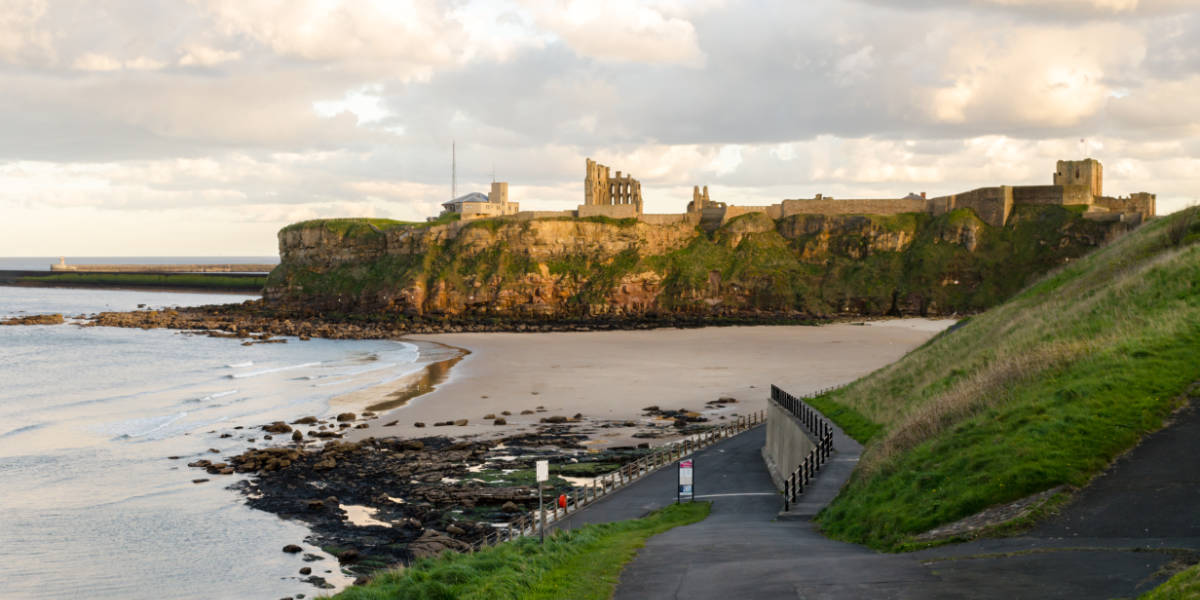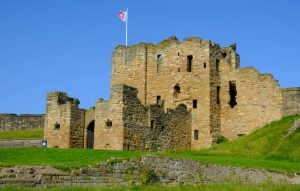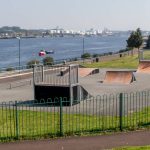
Tynemouth, the celebrated former Northumberland seaside town with a rugged coast and a story to tell.
Tynemouth is a beautiful coastal town which really started to thrive after the introduction of the railway. Before that, it was home to monks, several shipwrecks, and even a whole king’s army at one time. Sound interesting? Great! Here is everything you need to know about this perfect holiday town in Tyne & Wear.
The Early Days in Tynemouth
Tynemouth has always been occupied, for as long as there have been humans in Britain. This area of the coast was notoriously raided by Vikings. Before that, the Romans used it as a sensibly placed signal station from where they could oversee any potential trade up the especially important river. Historians suggest humans have been here since the Iron Age. The nearby Roman supply stop at Arbeia means we know they were definitely here. The Romans went back home circa the 4th century, though some would stay behind. By the 7th century, there was a thriving monastery here.
The monastery became fortified, probably because of the Vikings Viking along the shore. It was robbed at least three times and completely destroyed once. By 1083 the monks were back on top. In 651 the king of the lesser-known pre-England kingdom of Deira was laid to rest in the monastery. Later, The king of Northumbria would join him. King Malcolm III of Scotland was buried here briefly in 1093. He was removed to Glamis and the royal estate there. However, this gave the monastery three kings, wise or otherwise, and ever since the Tyneside coat of arms has three crowns on it.
Tynemouth Castle
The castle has a long history with royalty. Two King Edward’s left their Queens here while they attacked Scotland. When Edward II was beaten in Bannockburn, he caught a ship here. Prince Rupert of the Rhine landed at Tynemouth much later, in 1642, to come and join in the Civil War.
Tynemouth is unfortunately too far to the north for inclusion in the Domesday Survey of 1086. King William never quite took proper hold of the north of England. The farther from London they got, the less his officials recorded… in more ways than one. We imagine them seeing Hadrian’s Wall and taking that as a warning.
During the Medieval Period
The priory built the small fishing port and the village which began Tynemouth proper. In 1325, the finished port could start collecting a tithe from those who used it. Newcastle officials became furious because Tynemouth was ‘stealing’ some of their revenue. They demanded that they be the only ones to control trade on the Tyne. The prior was having none of it and continued. The war has raged ever since. That’s 900+ years of arguments.
In 1539, the Tynemouth Priory closed during Henry VIII’s Dissolution of the Monasteries. The Manor of Whitley was part of that. King Henry, I made a gift of the manor to the priory, forever tying the history of Whitely bay to the history of Tynemouth through monks. Well… at least until his namesake took it all away so he could marry numbers 3, 4, 5, and 6.
Henry VIII
Slightly later, in 1545, Henry VIII built a fort at Tynemouth. He used it as a base for his fleet when he decided to invade Scotland. The fort was there to defend the fleet, which was manned by Spanish mercenaries. As a result, the area earned the nickname of the Spanish Battery.
During the English Civil War of 1642-51, the Royalists held very few ports. Two of the most important were Newcastle and Tynemouth. After the dissolution of the Monasteries, Tynemouth priory became a fort on the headland. This coastal fortress protected the people of Tyne and Wear right up until 1956. Those guns oversaw the stretch of coast leading to Newcastle through two world wars – during the first of which bombing the coastline with ships was a practical tactic. Do take the walk out to see the fortress if you are in town.
Fun Facts and Trivia about Tynemouth
It’s time to put a pause on history and explore a bit of Tynemouth trivia. Here are a few facts to roll out at parties:
- Tynemouth was part of Northumberland right up until 1974. There are still elderly residents of the town who will always believe it so. The town was originally a county borough, too. Indeed, it will always be part of the historic county of Northumberland. The towns around the mouth of the river are Northumberland but those to the south are Durham.
- One of the top spots to sunbathe here in July and August is on Longsands. At some point in history, an intrepid explorer stood at the end of this gigantic stretch of sandy beach and wondered what to call it. They came up with the name ‘Longsands’ and, though unimaginative, nothing else seems to fit.
- In 1925 the town gained an outdoor pool between it and Cullercoats in the north. It became an overnight sensation, attracting people from all over the country.
- There is a hidden bay around the base of the priory. Named Edward’s Bay, possibly due to one of the kings who stayed there. This secluded bay is only reachable at certain points of the day due to the tide. We don’t recommend it unless you are an old pro at tide hopping.
- The North Pier in town took 40 years to build. 40 years. The architects made a mistake with the design which left it vulnerable to winter storms. In the end, they rebuilt it in a straight line and finished it in 1909… after beginning in 1954.
On the note of the bad design and slow construction, let’s return to history.
The Industrial Era in Tynemouth
Tynemouth became an incorporated borough as of 1849, which is pretty late in the grand scheme of things. Especially since there had been people living in this land since the Iron Age. It’s like giving someone a medal for participation when they have been participating for 900 years already. However, that’s just politics.
In 1860 the local school opened for the first time. Its name was the King’s School and Priory Primary School. The school moved into the heart of town in 1865, where it has served local children ever since. We do hope they have updated the curriculum.
On the 24th of November 1864, the sea around Tynemouth became treacherous during one long storm. 5 ships wrecked themselves on the shore, driven into the Black Middens Rocks. Among those ships was the SS Stanley, which sunk costing 34 lives. The ship weighed an estimated 552 tons. It belonged to the Aberdeen Steam Navigation Company and was travelling from Aberdeen down to London. The Black Middens rocks earned a reputation thereafter, part local ghost story and part warning to mariners.
The Train Arrives
Tynemouth train station first opened in 1882. The move encouraged countless city slickers out onto the quiet beaches and turned Tynemouth into a bit of a holiday destination. In 1878, the Plaza first opened. It was a landmark area of the town which overlooked Long Sands and help many stores. It burned to the ground in February 1996, a sad day for the town. In 1867, Tynemouth received its very own rowing club, which is still active today. They competed in countless competitions. You can read more about them here.
In 1895 the town finally gained a much-needed lighthouse. It opened on the old North Pier, which began construction in 1854 and finished in 1895. The original design was not storm proof. Something you would think they might have factored in before they began building.
Modern Tynemouth
In 1902, a statue of Queen Victoria was unveiled on the Village Green. This is where the war memorial to those killed in the Boer War stood. The added Great War memorials took their places in 1923 and then again after WWII. The 82 names from the Second World War didn’t make it onto the cenotaph until 1999. The town finally finished that pier we talked about in 1909. In 1903, they upgraded the lighthouse to a contemporary design, too.
Tynemouth became part of Tyne and Wear officially in 1974, prior to which it was still Northumberland.
In 2013, Longsands received the accolade of one of the country’s best beaches – as voted by no less than Trip Advisor themselves. It also made the list of top twenty beaches in Europe. The local school became a state academy in that same year. In 2018 the Sunday Times – which everyone trusts – voted Tynemouth as the best place to live in the whole of northern England.
Famous People that come from Tynemouth
We wouldn’t be Five Minutes Spare if we didn’t give you the scoop on who you might brush hands with over the bananas in the fruit aisle. Here are all our favourite celebs, both past and present, to have come from Tynemouth:
- The local school has had some famous faces attend it. Most famous is Stan Laurel, of Laurel and Hardy fame.
- Sir Ridley Scott, the famous film director, attended the school here.
- Racing driver Jason Plato also studied in Tynemouth.
- Andy Taylor, the guitarist from Duran Duran, lived here.
- Famous UK actress Denise Welch is a Tyneside gal.
- Graham Collier, the jazz musician, was a Tynemouth guy.
Not too many famous faces from modern times in Tynemouth, but we skipped right on by the footballers this time. If you are a fan of the big game, look out for Jimmy Miller, Mark Miller, James Oakley, Albert Pearson, Ray Slater, Ken Walshaw and probably others.
Top Attractions in Tynemouth
We have reached the part of the article where we reveal the best bits about the town, as told by the internet and the locals. Here are the best things you ought to see and do if you are in town.
Historic Sites

Image: Iordanis/Shutterstock.com
The fortress at Tynemouth contains a gatehouse, high walls, and a ruined fort. Visible for miles around, it is perched on the edge of the rocky shore, at the end of one of the best beaches in the area. If you only see one site while you are here, take a walk along the shore and up to this magnificent ruin. It will make the whole trip worthwhile, even in terrible weather. Known as the Spanish Battery, the headland is called Freestone Point. It has seen occupation since the Iron Age as it is an ideal place to watch ships come and go from the Tyne.
While you are over there, have a look at the ruins of Tynemouth Priory and what used to be the castle. You can see the ruins all laid out as a large square if you look at it from above. More of the priory remains than of the castle. It’s strange to think that the whole area was so busy for hundreds of years, and now we defend nothing but rocks and stones with our guns. English Heritage oversees the complete site.
Landmarks
Take the trip to the battery and visit the monument to Lord Nelson’s second in command, Lord Collingwood. After Nelson was killed in the Battle of Trafalgar, he won the day and brought his men home. He stands on a dais armed with four cannons from the HMS Royal Sovereign – his ship.
Cultural Sites
The best place to go and engage in some local culture here might be the Watch House Museum. The watch house belongs to the local Tynemouth Volunteer Life Brigade, who are somewhat similar to a lifeboat charity. They would watch the beaches for shipwrecks during storms or keep a check on local fisherfolk out on the high seas, waiting their return. The museum is filled with old artefacts regarding life on the sea. It began in 1864 and has run every day since driven by local volunteers who have an interest in keeping those out there safe.
The town has its own theatre. Head along to the Tynemouth Priory Theatre to catch a show. This is where you will spy your pantomimes in the holiday season. It is always booked up early so buy your tickets in advance.
Outdoor Attractions
There is only one real place to go and sunbathe, play water sports, set up your volleyball net, and eat sandy sandwiches in summer. Longsands is the place for you. It is such a massive beach that you could fit most of Newcastle on it, which occasionally happens on sunny summer weekend days. Arrive early to get the best spot. You can also head around to the end of the beach with King Edwards Bay on it. Remember to watch out for that tide. Historians suspect it earned its name from one of the Edwards who presumably visited when their queens stayed in the castle, before or after they raided Scotland.
Sports and Recreation
Tynemouth has its own aquarium and we don’t think that’s a cultural attraction, nor is it outdoors, so it ended up in the recreation section. Tynemouth Aquarium houses some of the most exciting sea animals in the world, or so they advertise. They have rockpool animals, and seal shows, and give regular talks about things like what types of animals live in rivers and what is native to the surrounding area. They entertain school groups and, if you really love it there, they give annual passes.
As for sports, those who love golf will find the Tynemouth Golf Club occasionally misty and reasonably flat. We understand flatness is important in golf.
Tynemouth United FC is the local junior football team. You can read about them here. They often have weekend matches that are free to watch. Tynemouth United are a young club, established in 07. Obviously, the big team in this area is Newcastle United. You had better not be a Sunderland fan if you want any respect in this town.
Shopping in Tynemouth
There is plenty of regular, bog-standard shopping in Tynemouth, or you could go to one of the market days and have a blast, instead. Tynemouth has been a market town for nearby traders ever since the prior opened up the village to fishing and trading. That was roughly 800 years ago. Nowadays, there is an indoor market which spills outdoors every week. They specialise in lovely antiques, fine art, and homemade street food. Get along to it and enjoy the experience. The organisers bill it as the most colourful market in the North East.
You should also hop into the Green Ginger Shopping Arcade while you are here. It lies across two levels of shops and looks like an old church. There is a retro sweet shop in there that gets a lot of love from locals.
Where to Eat and Drink?
One popular restaurant in town is the Longsands Fish Kitchen. They specialise in fresh catches and full bellies. If you like seafood you will not get fresher fair in the whole area. If you love pub grub, the Turks Head is a top choice for locals. You might also enjoy the Low Lights Tavern in nearby North Shields.
Alternative suggestion: take a picnic out to Effard Rocks and eat there. Enjoy stunning sea views for miles around and the calm tranquil sounds of rocks rolling on the shore as the waves come and go.
What to do with Kids in Tynemouth?
You can’t come to Tynemouth and not check out the park here. It has all sorts of rides, amusements, stalls, and other entertainment in it. It has a greenhouse, an inflatable section, a soft play and an adventure playground of various pirates, jungle, and other themes. There’s a kid-friendly restaurant on site, mini golf, and much more.
Other Notable Attractions in Tyne & Wear
You may have to spend more time here than you thought. You might even like it so much that you don’t want to leave. In either case, there are other sites you should see if you are in the area. Here are our favourites:
- Washington – did you know you could visit the town where George Washington’s family were the nobles? It’s just down the road.
- Want more seaside? You could try Whitley Bay.
- Follow the River Tyne four miles downstream from Newcastle and visit South Shields.
- Spend a day shopping in Sunderland.
- Go to Gateshead to visit the world-famous Angel of the North.
There are so many things to do in this part of the country that it’s only a shame the weather wasn’t better. Get out in summer to enjoy it fully or spend winters in the town’s cosy pubs in front of hearty fires, with friends.
How to Get to Tynemouth
We would not be particularly good travel guides if we forgot to give you some directions. Remember that it’s England. If you get lost or stuck somewhere, you can call a taxi to come and pick you up.
By Road
Follow the coast road east out of Newcastle and it’s a straight run.
By Rail
Tynemouth is on the metro line, rather than the train line. Get yourself to Newcastle and hop on the Metro.
By Air
Your nearest airport is Newcastle International. Sunderland is not far either.
By Sea
Head for the Port at Tynemouth. You can’t miss it. Watch out for the guns.
Got Five More?
If you find yourself at a loose end, we are always happy to have more readers. Give us a Facebook follow if you enjoyed the article and, if you just want to see if we have covered your town yet, you can browse our other travel articles to find out.
Header Image: Stuarts Photography/Shutterstock.com


